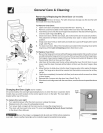
Porcelain Enamel Oven & Broiler Drawer
The oven interior is porcelain on steel and it is safe to clean using oven cleaners.
General Cleaning
Remove soils using hot, soapy water. Do not allow food spills with a high sugar or acid content (such as milk, tomatoes,
saukerkraut, fruit juices or pie filling) to remain on the surface as they may cause a dull spot even after cleaning.
To Remove Heavy Soil:
1. Allow a dish of ammonia to sit in the oven overnight or for several hours with the oven door closed. Clean softened dirt spots
using hot, soapy water. Rinse well with water and a clean cloth.
2. If soil remains, use a soap-filled scouring pad or a nonabrasive cleaner. If necessary, use an oven cleaner following
manufacturer's instructions. DO NOT mix ammonia with other cleaners.
3. Clean any soil from the oven frame, the door liner outside the oven door gasket and the small area at the front center of the
oven bottom. Clean with hot, soapy water. Rinse well using clean water and a cloth.
Adhere to the following precautions when using oven cleaners:
1. DO NOT spray cleaner on the electrical controls or switches because it could cause a short circuit and result in sparking
or fire.
2. DO NOT allow a film from the cleaner to build up on the temperature sensing bulb; it could cause the oven to heat improperly.
(The bulb is located on the left interior wall of the oven.) Carefully wipe the bulb clean after each oven cleaning, being careful
not to move the bulb. A change in its position could affect how the oven bakes. Avoid bending the bulb and capillary tube.
3. DO NOT spray any cleaner on the oven door trim or gasket, broiler drawer glides, handles or any exterior surfaces of the
range, plastic or painted surfaces. The cleaner can damage these surfaces.
Cleaning the Oven Bottom
The oven bottom is porcelain enamel and can be removed for easier cleaning. Clean using hot, soapy water, a mild
abrasive cleanser, a soap-filled abrasive pad or oven cleaner following manufacturer's instructions.
Raising & Lowering the Top for Cleaning
1. Remove burner grates and spillover bowls. Set aside.
MainTop 2. Grasp the sides of the cooktop and then lift from the front.
3. Lift the top high enough to allow the support rods to snap into place. The Lift-up rods
will support the top in its raised position.
4. Clean underneath using hot, soapy water and a clean cloth; then, dry.
5. To lower the range top, grasp the front corner of each side of the top while pushing back
on each rod with the heel of your hand. This will release the notched support. Hold the
range top and gently slide the range top down to the range.
When lowering the top, grasp the sides with fingertips only. Be careful not to pinch fingers. Also, DO NOT drop
or bend the rangetop when raising or lowering. This could damage the surface.
Removing & Replacing Gas Burners for Cleaning
To Remove Burners
1. Remove shipping screws with a Phillips Head screwdriver. See illustration for screw
locations.
2. Tilt the burner at the end closest to the support bar until the Iocator tab is released (front
burners tilt right, rear burners tilt left). Move the burner toward the back of the range. This
will separate it from the gas valve at the front of the range.
Support
Bar
To Replace Burners
1. Slide the burner tube over the gas valve at the front of the range (front burners fit over the
right valve, rear burners fit over the left valve on each side of the range).
2. Tilt burner so that the locating tab will slide into the slot on the support bar. Make sure
burners are properly seated on support bar and are level.
3. Replace shipping screws if desired.
DO NOT turn the burners on when the cooktop is raised for cleaning. Be sure
that the top is completely lowered and securely in place before turning on the burners.














